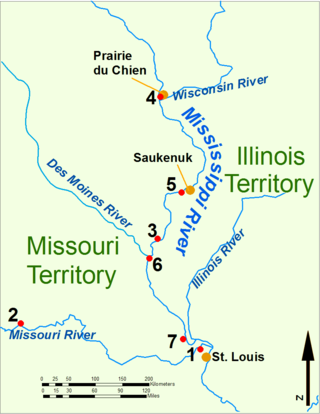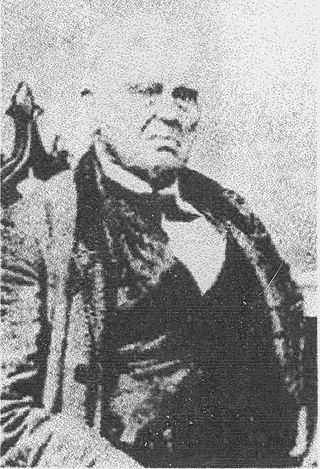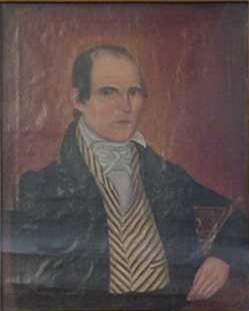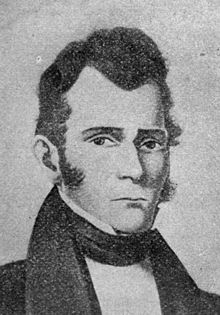
The Battle of Tippecanoe was fought on November 7, 1811, in Battle Ground, Indiana, between American forces led by then Governor William Henry Harrison of the Indiana Territory and tribal forces associated with Shawnee leader Tecumseh and his brother Tenskwatawa, leaders of a confederacy of various tribes who opposed European-American settlement of the American frontier. As tensions and violence increased, Governor Harrison marched with an army of about 1,000 men to attack the confederacy's headquarters at Prophetstown, near the confluence of the Tippecanoe River and the Wabash River.

Tecumseh was a Shawnee chief and warrior who promoted resistance to the expansion of the United States onto Native American lands. A persuasive orator, Tecumseh traveled widely, forming a Native American confederacy and promoting intertribal unity. Even though his efforts to unite Native Americans ended with his death in the War of 1812, he became an iconic folk hero in American, Indigenous, and Canadian popular history.

Tecumseh's War or Tecumseh's Rebellion was a conflict between the United States and Tecumseh's Confederacy, led by the Shawnee leader Tecumseh in the Indiana Territory. Although the war is often considered to have climaxed with William Henry Harrison's victory at the Battle of Tippecanoe in 1811, Tecumseh's War essentially continued into the War of 1812 and is frequently considered a part of that larger struggle. The war lasted for two more years, until 1813, when Tecumseh and his second-in-command, Roundhead, died fighting Harrison's Army of the Northwest at the Battle of the Thames in Upper Canada, near present-day Chatham, Ontario, and his confederacy disintegrated. Tecumseh's War is viewed by some academic historians as the final conflict of a longer-term military struggle for control of the Great Lakes region of North America, encompassing a number of wars over several generations, referred to as the Sixty Years' War.

Tenskwatawa was a Native American religious and political leader of the Shawnee tribe, known as the Prophet or the Shawnee Prophet. He was a younger brother of Tecumseh, a leader of the Shawnee. In his early years Tenskwatawa was given the name Lalawethika, but he changed it around 1805 and transformed himself from a hapless, alcoholic youth into an influential spiritual leader. Tenskwatawa denounced the Americans, calling them the offspring of the Evil Spirit, and led a purification movement that promoted unity among the Indigenous peoples of North America, rejected acculturation to the American way of life, and encouraged his followers to pursue traditional ways.

The siege of Fort Wayne took place from September 5 – September 12, 1812, during the War of 1812. The stand-off occurred in the modern city of Fort Wayne, Indiana between the U.S. military garrison at Fort Wayne and a combined force of Potawatomi and Miami forces. The conflict began when warriors under the Potawatomi Native American Chiefs Winamac, and Five Medals killed two members of the U.S. garrison. Over the next several days, the Potawatomi burned the buildings and crops of the fort's adjacent village, and launched assaults from outside the fort. Winamac withdrew on 12 September, ahead of reinforcements led by Major General William Henry Harrison.

Fort Harrison was a War of 1812 era stockade constructed in Oct. 1811 on high ground overlooking the Wabash River on a portion of what is today the modern city of Terre Haute, Indiana, by forces under command of Gen. William Henry Harrison. It was a staging point for Harrison to encamp his forces just prior to the Battle of Tippecanoe a month later. The fort was the site of a famous battle in the War of 1812, the siege of Fort Harrison in Sept. 1812 that was the first significant victory for the U.S. in the war. The fort was abandoned in 1818 as the frontier moved westward.
Colonel William Russell III was a soldier, pioneer, and politician from Virginia and Kentucky.

John Tipton was from Tennessee and became a farmer in Indiana; an officer in the 1811 Battle of Tippecanoe, and veteran officer of the War of 1812, in which he reached the rank of Brigadier General; and politician. He was elected to the Indiana General Assembly in 1819, and in 1831 as US Senator from the state of Indiana, serving until 1838. He was appointed as US Indian Agent and was selected to lead the militia in removing Menominee's band of Potawatomie in 1838; they were relocated to Kansas, Indian Territory.

During the War of 1812, the Illinois Territory was the scene of fighting between Native Americans and United States soldiers and settlers. The Illinois Territory at that time included the areas of modern Illinois, Wisconsin and parts of Minnesota and Michigan.

Colonel John Ketcham was an American surveyor, building contractor and judge.
Winamac was the name of a number of Potawatomi leaders and warriors beginning in the late 17th century. The name derives from a man named Wilamet, a Native American from an eastern tribe who in 1681 was appointed to serve as a liaison between New France and the natives of the Lake Michigan region. Wilamet was adopted by the Potawatomis, and his name, which meant "Catfish" in his native Eastern Algonquian language, was soon transformed into "Winamac", which means the same thing in the Potawatomi language. The Potawatomi version of the name has been spelled in a variety of ways, including Winnemac, Winamek, and Winnemeg.

Pigeon Roost State Historic Site is located between Scottsburg and Henryville, Indiana, United States. A one-lane road off U.S. Route 31 takes the visitor to the site of a village where Native Americans massacred 24 settlers shortly after the War of 1812 began.

Joseph Bartholomew was a general in the Indiana Militia and served in numerous military conflicts. He also worked as a farmer, hunter, trapper, self-taught surveyor, and politician. Bartholomew County, Indiana and the Bartholomew Trail were named after him.

Vallonia is an unincorporated community and census-designated place (CDP) in Driftwood and Brownstown townships, Jackson County, Indiana, United States. It was an 18th-century French settlement and 19th-century American frontier fortification known as Fort Vallonia. As of the 2010 census, Vallonia had a population of 336.

During the War of 1812, the Indiana Territory was the scene of numerous engagements which occurred as part of the conflict's western theater. Prior to the war's outbreak in 1812, settlers from the United States had been gradually colonizing the region, which led to increased tensions with local Native Americans and the outbreak of Tecumseh's War. In 1811, Tecumseh's confederacy, formed in response to encroachment by white American settlers, was defeated by U.S. forces at the Battle of Tippecanoe. After the conflict broke out, most Native Americans in the region joined forces with the British Empire and attacked American forces and settlers in concert with their British allies.

The Battle of Tipton's Island was an engagement between a Shawnee war party and Indiana militia under command of John Tipton in April 1813 on the White River near present-day Seymour, Indiana.
Tecumseh's confederacy was a confederation of indigenous peoples of the Great Lakes region of North America that began to form in the early 19th century around the teaching of Tenskwatawa, called The Prophet by his followers. The confederation grew over several years and came to include several thousand warriors. Shawnee leader Tecumseh, the brother of The Prophet, developed into the leader of the group as early as 1808. Together, they worked to unite the various tribes against the European settlers who had been crossing the Appalachian Mountains and settling on their land.

The Battle of Wild Cat Creek was the result of a November 1812 punitive expedition against Native American villages during the War of 1812. It has been nicknamed "Spur's Defeat", which is thought to refer to the spurs used by the soldiers to drive their horses away from the battle as quickly as possible. The campaign is sometimes referred to as the Second Battle of Tippecanoe.
United States Rangers were originally raised for Tecumseh's War, but they continued to serve against hostile Indians after the United States declaration of war against Great Britain. A total of 17 independent companies were authorized from Kentucky, Ohio, Indiana, Illinois and Missouri. The Rangers were neither militia, nor regulars, but formed part of the war establishment of the United States as volunteers.
















